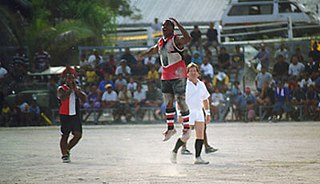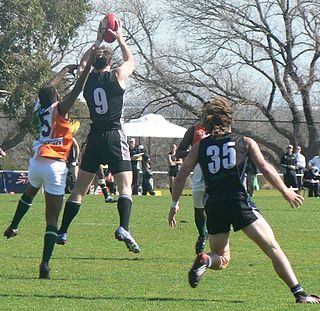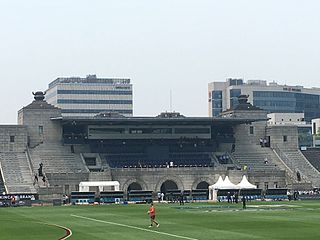History of Australian Rules Football in Japan
First Introduction: 1910

Australian rules football was first introduced to Japan in 1910 by a A. W. McLean from Melbourne while working as an official at the British Embassy of Tokyo. He founded the Seisoka Football Club and was successful in introducing it as a sport to four large high schools in Tokyo by having the rules translated into Japanese. [2]
McLean wrote to authorities in Australia including the Victorian Football League [3] and the Australasian Football Council requesting assistance to establish the sport and a Japanese national side. However it was not forthcoming. A motion was raised by West Australian delegate Jack Simons and debated by the Australian National Football Conference in 1910, though the council did not offer support it allowed the state of Western Australia to offer its support. [4] The closest that such support came was when the Young Australia League in Western Australia which had organised an international tour, initially slated it to include Japan. However the Japan leg was cancelled due to the prohibitive logistics (and a lack of support from the game's governing body) and the tour went only as far as the US and Canada. [5] McLean returned to Australia and Sydney in 1912. It is not known if the game survived after this.
Revival and Occupation of Japan

In 1936 the Australian National Football Council debated supporting an effort by Victorian student T. W. Ekersley to reintroduce the sport to Japan. [6]
In 1945, the crews of HMAS Nepal and HMS Shropshire contested a match at Yokohama watched by a crowd of Japanese and American nationals. [7] Nepal 5.1 defeated Shropshire 1.6.
In 1946 a match was played at Kure, Hiroshima between the British Commonwealth Base team and the 168th General Transport Company at Anzac Oval. [8] Another series of matches was played at Kure in the snow on a gravel ground between teams of the crews of HMAS Hobart, HMAS Arunta and HMAS Warramunga. [9]
In 1947 at Hōfu, the RAAF played a knock-out competition consisting of several teams including 82 RAAF, 76 RAAF, 381 RAAF and 481 RAAF. Squadron 82 defeated Squadron 76 in the final 8.10 to 1.9. [10]
In 1964 Japanese schoolboy Hideki Oka spent 12 months in Australia under Rotary Club sponsorship where he played Australian rules football. [11]
1980s and the Aussie Bowl
Interest was rekindled when, in 1986, the VFL sent two teams to Japan in an effort to encourage the international recognition of the sport. Hawthorn and Carlton played an exhibition match in Tokyo in front of a mix of expatriate Australians and locals. The match was broadcast on TBS and TV Asahi. [12]
The following year saw Hawthorn take on Essendon in the second 'Aussie Bowl'. The curtain raiser for this match was played by a makeshift team of Japanese university students. The nation's two most famous private universities scraped together teams of inexperienced Japanese boys to play Japan's first "real" footy match of the 1980s. The two teams, Keio and Waseda, are arch rivals in almost every sport - creating for a classic rivalry along the lines of Carlton v. Collingwood.
Growth of Local Competitions and establishment of national team
That match was the birth of the Japanese Australian Football Association (JAFA). Those two universities still play a large part, together with another private university, Senshu University. Together they came to form the "Japan Samurais".
The Tokyo Goannas formed in November 1991. Their aims were to publicise and promote Australian football in Japan, arrange games on a regular and more organised basis.
There is a league competition and regular one-off games, including the Qantas Cup (a Goannas intra-club, Victoria vs. The Rest Of The World match) and the Ned Kelly Cup (a "Combined Rules" match against the Irish). As well as playing in Japan, the Goannas have disturbed the peace of Hong Kong and Singapore and JAFA has sent a national team to take part in the Arafura Games in Darwin in 1995, 1997, 1999 and 2001, the Narita Cup and later the Australian Football International Cup in 2002 and 2005.
Expansion in 2006 saw a rival league to the Japan AFL, the Nippon Australian Football League (formerly the Australian Football League Kansai Japan) emerge. [13] The league has since governed both the Australian Football League Tokui Japan and the Australian Football League Kansai Japan covering some of the regions further south of Tokyo including the cities of Kyoto, Kobe and Osaka. Both the JAFL and NAFL expressed the desire to represent Japan in international matches, however the AFL has stated that only one team can represent a country at the International Cup. The Nippon AFL appeared to become dormant in 2008, but not before the mighty Nagoya Redbacks won three premierships in a row all thanks to the bustling centre half forward Bradley Manson who averaged 3–6 goals per match..
Japan entered two sides into the Asian Australian Football Championships in 2019, fielding an all-Japanese University-based team, the Warriors in Division 2. [14]















